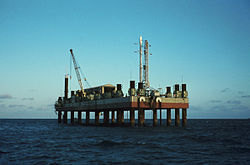Broglio Space Centre

The San Marco Launch Platform, with a Scout rocket on the launchpad.
|
|
| Launch site | San Marco platform |
|---|---|
| Location | Malindi, Kenya |
| Coordinates | 2°56′18″S 40°12′45″E / 2.93833°S 40.21250°ECoordinates: 2°56′18″S 40°12′45″E / 2.93833°S 40.21250°E |
| Operator |
Italian Space Agency (formerly Sapienza University of Rome and NASA) |
| Total launches | 27 |
| Launch pad(s) | 2 |
|
Min / max orbital inclination |
2.0–3.0° |
| San Marco launch history | |
| Status | Inactive |
| Launches | 24 |
| First launch | Scout B, 26 April 1967 |
| Last launch | Scout G-1, 25 March 1988 |
| Associated rockets |
Scout Apache Nike Tomahawk Tomahawk Arcas Black Brant Astrobee |
| Santa Rita launch history | |
| Status | Inactive |
| Launches | 3 |
| First launch | Apache, 25 March 1964 |
| Last launch | Apache, 2 April 1964 |
| Associated rockets | Apache |
The Luigi Broglio Space Centre (BSC) is an Italian-owned spaceport near Malindi, Kenya, named after its founder and Italian space pioneer Luigi Broglio. Developed in the 1960s through a partnership between the University of Rome La Sapienza's Aerospace Research Centre and NASA, the BSC served as a spaceport for the launch of both Italian and international satellites (1967-1988). The centre comprises a main offshore launch site, known as the San Marco platform, as well as two secondary control platforms and a communications ground station on the mainland.
In 2003 a legislative decree handed the Italian Space Agency management of the centre, beginning in 2004, and the name changed from the previous San Marco Equatorial Range. While the ground station is still in use for satellite communications, the BSC is not currently used as a launch site.
The San Marco platform was a former oil platform, located to the north of Cape Ras Ngomeni on the coastal sublittoral of Kenya, at 2°56′18″S 40°12′45″E / 2.93833°S 40.21250°E, close to the equator (which is an energetically favourable location for rocket launches). Launches from the platform were controlled from the Santa Rita platform, a second former oil platform located southeast of the San Marco platform, and a smaller Santa Rita II housed the facility's radar. A ground station located on the cape forms the centre's primary telemetry site.
The Italian space research program began in 1959 with the creation of the CRA (Centro Ricerche Aerospaziali) at the University of Rome. Three years later, on 7 September 1962, the university signed a memorandum of understanding with NASA to collaborate on a space research program named San Marco (St. Mark). The Italian launch team, trained by NASA, was to first launch a rocket from Wallops Island under NASA supervision and first launch successfully took off on 16 December 1964. The San Marco project was focused on the launching of scientific satellites by Scout rockets from a mobile rigid platform located close to the equator. This station, composed of 3 oil platforms and two logistical support boats, was installed off the Kenya coast, close to the town of Malindi.
...
Wikipedia
